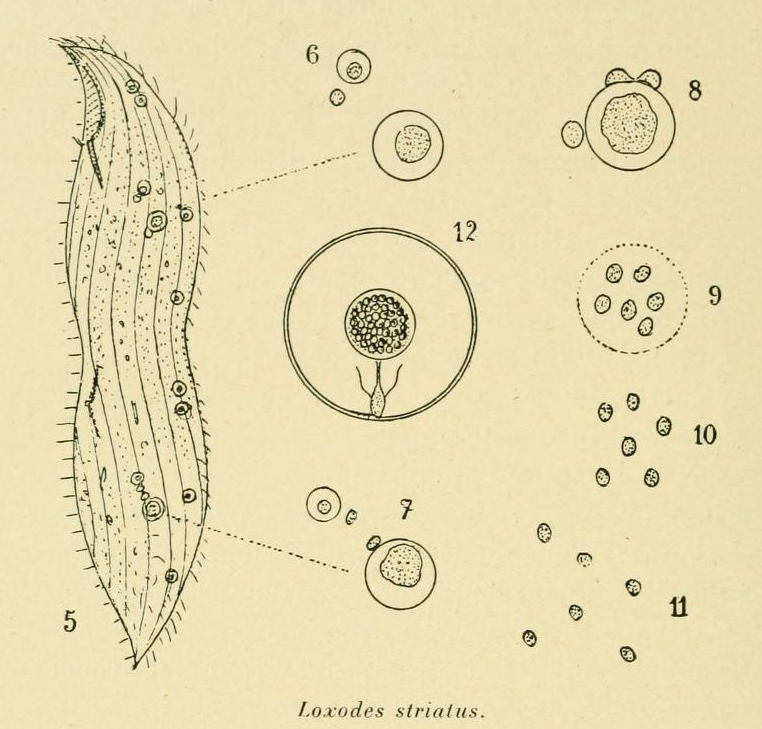Müllerian Vesicle on:
[Wikipedia]
[Google]
[Amazon]
Loxodidae is a family of karyorelict ciliates.
Loxodidae members possess an elongated, laterally flattened shape. They share two key characters: a beak-like anterior rostrum interrupting the perioral kineties, and peculiar cytoplasmic organelles named Müller vesicles.
The extensive development of lacunae of the smooth endoplasmic reticulum leads to strong vacuolization of the endoplasm. This feature is associated to a lack of contractile vacuoles in all loxodids.
The term ''Loxodidae'' derives from the
 Loxodidae members possess the ability to orient themselves in oxygen gradients. They use
Loxodidae members possess the ability to orient themselves in oxygen gradients. They use
ancient Greek
Ancient Greek (, ; ) includes the forms of the Greek language used in ancient Greece and the classical antiquity, ancient world from around 1500 BC to 300 BC. It is often roughly divided into the following periods: Mycenaean Greek (), Greek ...
(), meaning "oblique, tilted".
Gravitaxis
 Loxodidae members possess the ability to orient themselves in oxygen gradients. They use
Loxodidae members possess the ability to orient themselves in oxygen gradients. They use gravity
In physics, gravity (), also known as gravitation or a gravitational interaction, is a fundamental interaction, a mutual attraction between all massive particles. On Earth, gravity takes a slightly different meaning: the observed force b ...
as a stimulus for this spatial orientation, a phenomenon called gravitaxis
Gravitaxis (or ''geotaxis'') is a form of taxis characterized by the directional movement of an organism in response to gravity.
There are a few different causes for gravitaxis. Many microorganisms have receptors like statocysts that allow them to ...
or geotaxis.
Loxodid ciliates must therefore have developed mechanoreceptors
A mechanoreceptor, also called mechanoceptor, is a sensory receptor that responds to mechanical pressure or distortion. Mechanoreceptors are located on sensory neurons that convert mechanical pressure into electrical signals that, in animals, ar ...
informing them about what is up or down. A likely candidate structure for their gravitaxis is the Müller vesicle.
Müller vesicle
Müller vesicles (also known as Müllerian vesicles, or spelled ''Mueller'') arestatocyst
The statocyst is a balance sensory receptor present in some aquatic invertebrates, including bivalves, cnidarians, ctenophorans, echinoderms, cephalopods, crustaceans, and gastropods, A similar structure is also found in '' Xenoturbella''. T ...
-like organelle
In cell biology, an organelle is a specialized subunit, usually within a cell (biology), cell, that has a specific function. The name ''organelle'' comes from the idea that these structures are parts of cells, as Organ (anatomy), organs are to th ...
s uniquely found in ciliates of the family Loxodidae. They are named after the Danish zoologist Otto Friedrich Müller
Otto Friedrich Müller, also known as Otto Friedrich Mueller (2 November 1730 – 26 December 1784) was a Denmark, Danish natural history, naturalist and scientific illustrator.
Biography
Müller was born in Copenhagen. He was educated for the ch ...
. Eugène Penard was the first to propose that these vesicles were analogous to statocyst
The statocyst is a balance sensory receptor present in some aquatic invertebrates, including bivalves, cnidarians, ctenophorans, echinoderms, cephalopods, crustaceans, and gastropods, A similar structure is also found in '' Xenoturbella''. T ...
s, which are the gravity-sensing structures of animals. Each Müller vesicle is spherical, about 7 μm across (in ''Loxodes''), and is bounded by a membrane. It contains a Müller body, which comprises mineral concretions in an organic matrix bounded by a membrane, that is suspended in a vacuole by a stalk. The stalk is about 0.3–0.4 μm thick, and contains microtubules that connect the Müller body with the adjacent kinety, which is believed to help transmit the sensory signal to the rest of the cell. The mineral concretions are mostly salts of strontium
Strontium is a chemical element; it has symbol Sr and atomic number 38. An alkaline earth metal, it is a soft silver-white yellowish metallic element that is highly chemically reactive. The metal forms a dark oxide layer when it is exposed to ...
in the genus '' Remanella'', but barium
Barium is a chemical element; it has symbol Ba and atomic number 56. It is the fifth element in group 2 and is a soft, silvery alkaline earth metal. Because of its high chemical reactivity, barium is never found in nature as a free element.
Th ...
in '' Loxodes''.
Phylogeny
Molecular phylogeny based on sequences of the SSU rRNA gene indicates that ''Remanella'' and ''Loxodes'' branch together into amonophyletic
In biological cladistics for the classification of organisms, monophyly is the condition of a taxonomic grouping being a clade – that is, a grouping of organisms which meets these criteria:
# the grouping contains its own most recent co ...
family Loxodidae.
References
External links
* {{Taxonbar, from=Q18573101 Karyorelictea Ciliate families